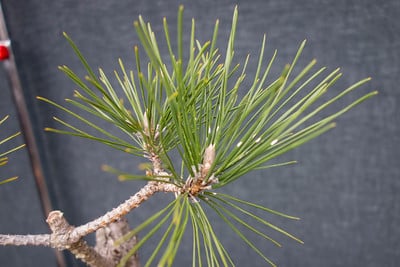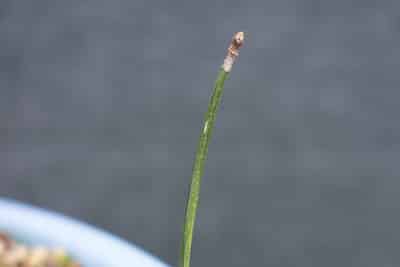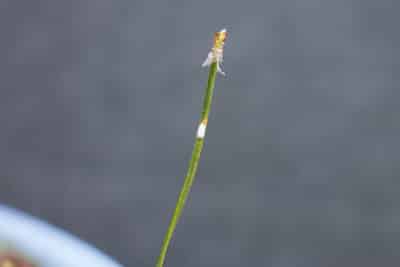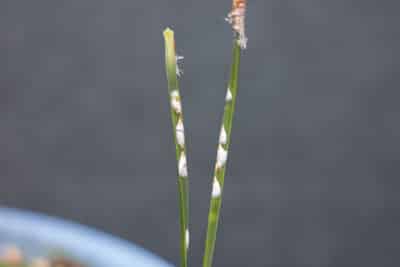The pine needle scale can be tricky to spot. Small, white spots are the giveaway.

Uh-oh, white spots
If it’s fall or early spring where I live, it’s always what I think it is – pine needle scale. Here’s why they can be tricky to spot. When they grow on the inside surface of a pair of pine needles, they’re all but invisible.

A sliver of white is the giveaway
Peeling the needles apart reveals the insect – small white spot with even smaller yellow dot at one end.

Pine needle scale
If I’ve spotted them early enough, I’ll find singles or pairs of them on a limited number of needles. If I do nothing about it, a few days later I might find far more.

Yuck – more pine needle scales!
The reason I’m not a fan – they can be hard to control. Many of the weaker pesticides have trouble killing scale. I usually start with light-touch approaches and mount increasingly potent assaults as need be. My general approach is the same as it is for any scale:
- If there are only a few I’ll scrape them off with my fingernail
- If I have to spray, I’ll start with oils
- If oils don’t get them under control, I’ll using something more toxic, though I typically avoid this last step as I don’t like using pesticides.
What’s the most important thing to know about treating scale? If at all possible, avoid getting it in the first place. How might one go about reducing the potency and number of infestations?
- Keep your trees healthy. This includes lots of sunshine, appropriate water and fertilizer and well-draining soil.
- Don’t give them space to hide. Leaving old leaves or needles in place prevents light and air from reaching the tree’s interior – that’s how scale like it.
- Use oils on a regular basis. Oil sprays are the least toxic treatment for scale.
- If you know there are lots of scale in the area or have fought infestations in the past, systemic pesticides are a good bet.
Uncontrolled scale infestations can greatly weaken and even kill bonsai. Be on the lookout for them!
Subscribe to Bonsai Tonight
New Posts Delivered Every Tuesday and Friday
Mac says
Geez Louise! One more thing to worry about out on the evergreen bench. Now I got to start parting pine tree needles and looking for little terrorists sucking the life out of them. I am guilty of being a fan of systemics, Bayer brand for the most part. At least it will kill little buggers before they can do hardly any damage.
fm says
What systemic pesticides are most effective for pine needle scale?
Mac says
Reading label on Bayer Advanced Tree & Shrub and it says, “Kills. Adelgids, Aphids, Borers (including Emerald Ashe Borer), Caterpillars, Japanese Beetles, Leafminers, Scale, Whiteflys and other listed pests.”
Mac says
I forgot to add that I have been using it for four years. It is effective for 12 months so you don’t need to apply but once in the Spring when growth is moving along so the tree will take it up when applied. An insect that will do damage to a treated tree gets one go at it and then dies, damage is very limited if you get an infestation of something.
Around our area Sawfly Larva are very happy to set up camp on your pines. With this stuff they only get one bite at the base of a needle and they are gone. Before I started using it it would not be uncommon to bump a pine limb with a watering tool and see a hand full of needles fall off where they had been working the night before. That was the main reason I started using it. You can’t see those darn things until they have done extensive work on your trees.
I have heard some objections about using it on flowering trees because it will kill bees that come and take nectar. I have no idea if that is correct or not. It would be good if someone that knows facts, not speculation, as to if that is true or not.
sikadelic says
Jonas,
When switching from oils to something stronger, how much time do you wait before trying a pesticide?
Jonas Dupuich says
When to switch from oils to something stronger? I try to use oils before I notice infestation or when one is just getting underway. By catching pests early the oils often do the trick.
Because oils are very effective against some pests like aphids the oils are often enough for more serious infestations too. If, however, I was faced with a serious scale or mite infestation, I might start with both contact spray and systemic.
As for the timing, I’d follow the instructions. If the label recommends reapplying oil after 7-14 days, I switch to another approach after 7-14 days.
I find I’m often trying to balance tree health with a strong desire to limit the amount of pesticides I apply – and usually the desire to avoid pesticides wins.